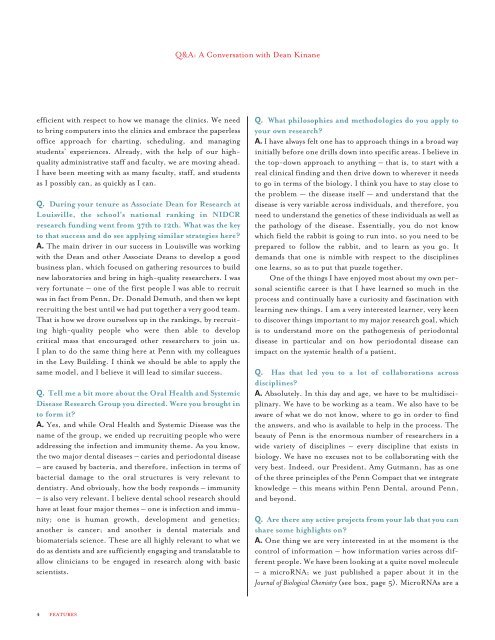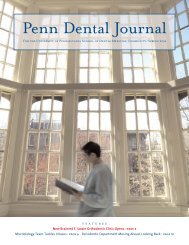penn dental - University of Pennsylvania School of Dental Medicine
penn dental - University of Pennsylvania School of Dental Medicine
penn dental - University of Pennsylvania School of Dental Medicine
Create successful ePaper yourself
Turn your PDF publications into a flip-book with our unique Google optimized e-Paper software.
efficient with respect to how we manage the clinics. We need<br />
to bring computers into the clinics and embrace the paperless<br />
<strong>of</strong>fice approach for charting, scheduling, and managing<br />
students’ experiences. Already, with the help <strong>of</strong> our highquality<br />
administrative staff and faculty, we are moving ahead.<br />
I have been meeting with as many faculty, staff, and students<br />
as I possibly can, as quickly as I can.<br />
Q. During your tenure as Associate Dean for Research at<br />
Louisville, the school’s national ranking in NIDCR<br />
research funding went from 37th to 12th. What was the key<br />
to that success and do see applying similar strategies here?<br />
A. The main driver in our success in Louisville was working<br />
with the Dean and other Associate Deans to develop a good<br />
business plan, which focused on gathering resources to build<br />
new laboratories and bring in high-quality researchers. I was<br />
very fortunate – one <strong>of</strong> the first people I was able to recruit<br />
was in fact from Penn, Dr. Donald Demuth, and then we kept<br />
recruiting the best until we had put together a very good team.<br />
That is how we drove ourselves up in the rankings, by recruiting<br />
high-quality people who were then able to develop<br />
critical mass that encouraged other researchers to join us.<br />
I plan to do the same thing here at Penn with my colleagues<br />
in the Levy Building. I think we should be able to apply the<br />
same model, and I believe it will lead to similar success.<br />
Q. Tell me a bit more about the Oral Health and Systemic<br />
Disease Research Group you directed. Were you brought in<br />
to form it?<br />
A. Yes, and while Oral Health and Systemic Disease was the<br />
name <strong>of</strong> the group, we ended up recruiting people who were<br />
addressing the infection and immunity theme. As you know,<br />
the two major <strong>dental</strong> diseases – caries and periodontal disease<br />
– are caused by bacteria, and therefore, infection in terms <strong>of</strong><br />
bacterial damage to the oral structures is very relevant to<br />
dentistry. And obviously, how the body responds – immunity<br />
– is also very relevant. I believe <strong>dental</strong> school research should<br />
have at least four major themes – one is infection and immunity;<br />
one is human growth, development and genetics;<br />
another is cancer; and another is <strong>dental</strong> materials and<br />
biomaterials science. These are all highly relevant to what we<br />
do as dentists and are sufficiently engaging and translatable to<br />
allow clinicians to be engaged in research along with basic<br />
scientists.<br />
4 features<br />
Q&A: A Conversation with Dean Kinane<br />
Q. What philosophies and methodologies do you apply to<br />
your own research?<br />
A. I have always felt one has to approach things in a broad way<br />
initially before one drills down into specific areas. I believe in<br />
the top-down approach to anything – that is, to start with a<br />
real clinical finding and then drive down to wherever it needs<br />
to go in terms <strong>of</strong> the biology. I think you have to stay close to<br />
the problem — the disease itself — and understand that the<br />
disease is very variable across individuals, and therefore, you<br />
need to understand the genetics <strong>of</strong> these individuals as well as<br />
the pathology <strong>of</strong> the disease. Essentially, you do not know<br />
which field the rabbit is going to run into, so you need to be<br />
prepared to follow the rabbit, and to learn as you go. It<br />
demands that one is nimble with respect to the disciplines<br />
one learns, so as to put that puzzle together.<br />
One <strong>of</strong> the things I have enjoyed most about my own personal<br />
scientific career is that I have learned so much in the<br />
process and continually have a curiosity and fascination with<br />
learning new things. I am a very interested learner, very keen<br />
to discover things important to my major research goal, which<br />
is to understand more on the pathogenesis <strong>of</strong> periodontal<br />
disease in particular and on how periodontal disease can<br />
impact on the systemic health <strong>of</strong> a patient.<br />
Q. Has that led you to a lot <strong>of</strong> collaborations across<br />
disciplines?<br />
A. Absolutely. In this day and age, we have to be multidisciplinary.<br />
We have to be working as a team. We also have to be<br />
aware <strong>of</strong> what we do not know, where to go in order to find<br />
the answers, and who is available to help in the process. The<br />
beauty <strong>of</strong> Penn is the enormous number <strong>of</strong> researchers in a<br />
wide variety <strong>of</strong> disciplines – every discipline that exists in<br />
biology. We have no excuses not to be collaborating with the<br />
very best. Indeed, our President, Amy Gutmann, has as one<br />
<strong>of</strong> the three principles <strong>of</strong> the Penn Compact that we integrate<br />
knowledge – this means within Penn <strong>Dental</strong>, around Penn,<br />
and beyond.<br />
Q. Are there any active projects from your lab that you can<br />
share some highlights on?<br />
A. One thing we are very interested in at the moment is the<br />
control <strong>of</strong> information – how information varies across different<br />
people. We have been looking at a quite novel molecule<br />
– a microRNA; we just published a paper about it in the<br />
Journal <strong>of</strong> Biological Chemistry (see box, page 5). MicroRNAs are a




